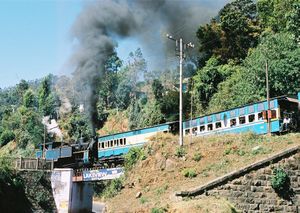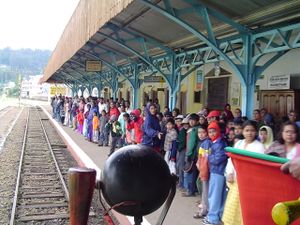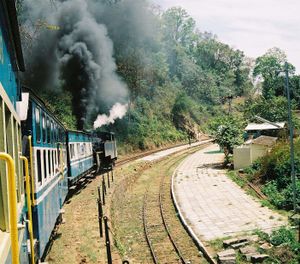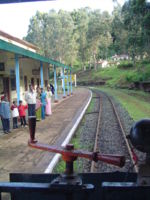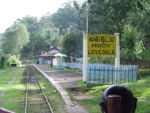Nilgiri Mountain Railway
The Nilgiri Mountain Railway (NMR) connects the town of Mettupalayam with the hill station of Udagamandalam, in the Nilgiri Hills of southern India. Both towns are in the state of Tamil Nadu. It is the only rack railway in India, and uses the Abt system.
History
The Nilgiri Mountain railway is one of the oldest mountain railways in India. Under consideration since 1845, the line was finally opened by the British in 1899, and was initially operated by the Madras Railway Company. The railway is one of the few in the world to be dependent on steam locomotives.
The Palghat division of the Indian Railways, which operates the NMR, incurs an annual shortfall of Rs 4 crores, (~1 million USD). During the Centenary celebrations of Nilgiri Mountain Railway in 1999 the then Railway Minister Nitish Kumar announced that the line would soon be electrified.
In July 2005, UNESCO added the NMR as an extension to the World Heritage Site of Darjeeling Himalayan Railway [1] after it satisfied the necessary criteria, thus forcing abandonment of modernisation plans. [2]
Operation
The NMR track is 1 m (3 ft 33⁄8 in) gauge, but the railway is isolated from the other narrow gauge lines.
Below Coonoor the line uses the rack and pinion system to climb the steep gradient. On the rack section trains are operated by steam rack locomotives manufactured by the Swiss Locomotive and Machine Works of Winterthur in Switzerland, which are always marshalled at the downhill (Mettupalayam) end of the train.
The average gradient in this rack section is 1 in 24.5, with a maximum of 1 in 12.
Currently (2005), there is only one train a day over the rack section, starting from Mettupalayam in the early morning and return there in the early evening.
Between Coonoor and Udagamandalam the train is operated by a YDM4 diesel locomotive using conventional rail adhesion principles. On this section the locomotive is always at the Coonoor end of the train as although the line is not steep enough to need a rack rail the ruling gradient out of Coonoor is still very steep at 1 in 25.
Between Coonoor and Udagamandalam (in 2005) there are four trains, each way, a day.
The diesel locomotives can only operate on upper section, but the steam locomotives can be used either with or without the rack section as well when required.
The majority of repairs to the locomotives are carried out at Coonoor shed but many of the steam locomotives have been rebuilt at the Goldern Rock workshops. Carriages are repaired at Mettupalayam but, like the locomotives, are taken to one of the big railway workshops for major work.
The Route
The train covers a distance of 46 km (28 miles), travels through 208 curves, 16 tunnels, and 250 bridges. The uphill journey takes around 290 minutes and the downhill journey 215 minutes.
- Mettupalayam - 0km, 1069ft above sea level - Junction with the Broad Gauge line from Coimbatore. Passengers cross the platform to the Nilgiri train. There is a small locomotive shed here and the carriage workshops for the line.
- Leaving Mettupalayum, the line is adhesion worked and actually drops for a short distance before crossing a wide river called Bhavaani and starting to climb gently.
- Kallar - 8km, 1260ft - Closed as a passenger station, this is where the rack rail begins. As the train leaves the station, the gradient is 1 in 12.
- Adderly - 13km, 2390ft - Closed as a passenger station but is still a water stop.
- Hillgrove - 18km, 3580ft - Block post and water stop as well as having refreshments for passengers.
- Runneymede - 21km, 4612ft - Closed as a passenger station but is still a water stop.
- Kateri Road - 25km, 5070ft - Closed as a passenger station, trains do not stop here.
- Coonoor - 28km, 5616ft - main intermediate station on the line at site of the locomotive workshops as well as the top end of the rack rail. Trains must reverse a short distance before continuing their climb to Ooty. It is normal for the locomotive to be changed here with diesel traction being normal for all trains to Ooty.
- Wellington - 29km, 5804ft
- Aruvankadu - 32km, 6144ft
- Ketti - 38km, 6864ft
- Lovedale - 42km, 7694ft
- From a short distance before Lovedale the line descends all the way into Ooty.
- Ooty - 46km, 7228ft (2200 m).
See also
External links
- Indian railways site on the NMR
- Railmuseum
- Images and info
- Toy train chugs on
- Ooty train Photographs
- 20 photos between Ooty and Coonoor
Agra Fort | Ajanta Caves | Champaner-Pavagadh Archaeological Park | Chhatrapati Shivaji Terminus | Churches and Convents of Goa | Elephanta Caves | Ellora Caves | Fatehpur Sikri | Great Living Chola Temples | Hampi | Humayun's Tomb | Kaziranga | Keoladeo | Khajuraho | Mahabalipuram | Mahabodhi Temple | Manas Wildlife Sanctuary | Mountain Railways of India | Nanda Devi and Valley of Flowers | Pattadakal | Qutub Minar | Rock Shelters of Bhimbetka | Sanchi | Sun Temple, Konarak | Sundarbans | Taj Mahal
